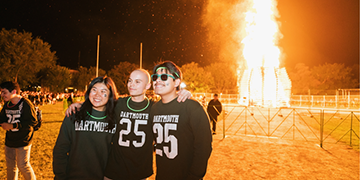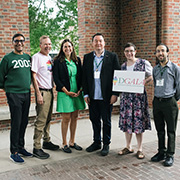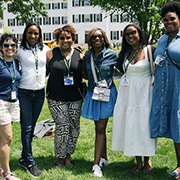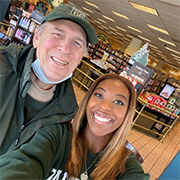50 for 50 Podcast: Mateo Romero ’89
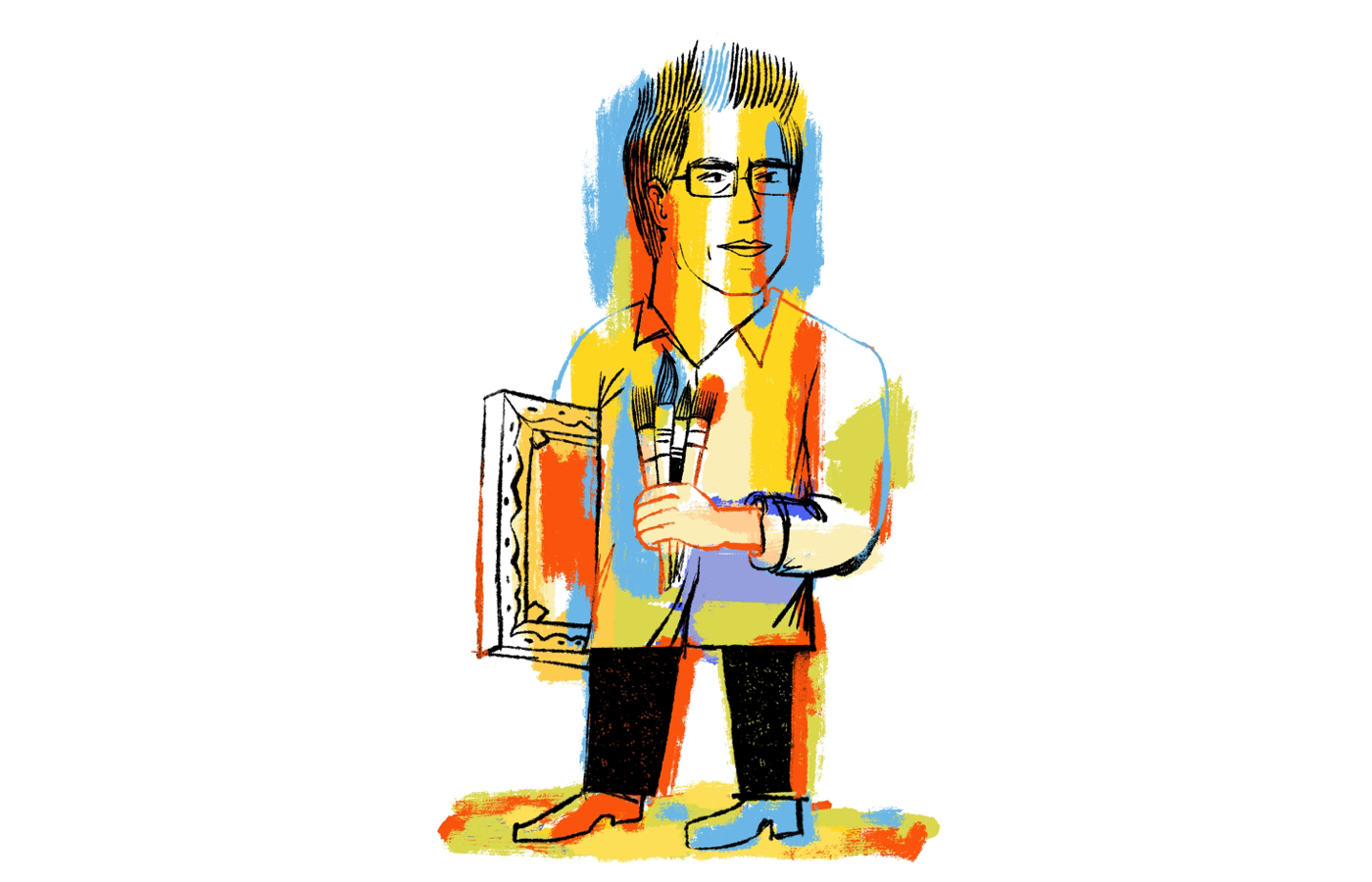
May 5, 2022
20 minute read
20 minute read
Mateo Romero '89
As Dartmouth College celebrates three milestone anniversaries, we meet acclaimed visual artist Mateo Romero, Class of 1989. Raised in Berkeley, California, Romero is a member of the Cochiti Pueblo Tribe and now lives and works in New Mexico.
Romero belongs to a large family of accomplished painters, photographers, and ceramists who are preserving, documenting, and celebrating Indigenous culture—as well as depicting the landscapes to which Native Americans feel spiritually connected.
Romero talks with his friend and classmate, podcast host Jennifer Avellino, about the things that have profoundly influenced and emboldened his work.
Transcript
Jennifer Avellino:
Hi everyone. And welcome to our 50 for 50 podcast, 50 stories for 50 years as we celebrate three major milestones in Dartmouth's history. As many of you know, and some of you can remember firsthand, 1972 was a pivotal year. Women joined the undergraduate community as Dartmouth students following several years of women exchange students on campus. The Black Alumni of Dartmouth Association or BADA is also entering its 50th year, and so is the Native American Studies Program. Quite the trifecta of anniversaries, and also not a coincidence that so much happened during this critical time.
I'm Jennifer Avelino, class of 1989, past president of the Dartmouth Alumni Council, and a former senior producer at CNN. As a journalist, my early days were spent as the news director for WDCR and WFRD, Dartmouth Broadcasting. I've had the good fortune to meet and bring to the airwaves remarkable people over the years, and this podcast, in many ways, brings me home.
Over the next few months, I'll be talking to inspiring, influential, and fascinating Dartmouth alumni. They'll reflect on what it was like to be a woman, a Native American, a person of color at Dartmouth, and how their time at the college led to the lives they're pursuing today.
Our guest today is Mateo Romero, an award-winning painter well-known for his bold use of color and texture with thick strokes of oil paint in his portraits and landscapes. After graduating from Dartmouth in 1989, he attended the Institute of American Indian Arts in Santa Fe, New Mexico, and later received an MFA in printmaking from the University of New Mexico. His work has been exhibited around the United States and Canada. In 2019, he and his brother Diego were named living treasures by Santa Fe's Museum of Indian Arts and Culture, an award honoring native artists who've made outstanding contributions to indigenous arts and culture. Mateo, welcome.
Mateo Romero:
Thank you. Thanks for having me on. Thanks for that wonderful introduction.
Jennifer Avellino:
Great to have you with us, good to see you, and hear you here on the airwaves. The Annual Powwow takes place in early May on the Dartmouth Green. The 50th honoring Powwow is happening this spring. In 2009, you were commissioned by The Hood Museum to create a series of 10 paintings inspired by the Dartmouth Powwow of that year. What was that whole experience like for you? And tell me about the specific process you used to create the paintings.
Mateo Romero:
Absolutely. It was an amazing experience. We initially approached James and Susan Wright, and they were incredibly supportive. And they were huge fans of Louise Erdrich. And at the time, we were doing a lot of photographic mixed media painting. We were doing these large formats, photographic embedded, transferred portraits. My wife Melissa and I went out to the Powwow, and we spent the time taking photographs of people that were... Dartmouth people who were dancing, and former alums, and native people out at the Powwow. And it was really amazing, actually. I was a little bit starstruck. I took a portrait of Louise Erdrich, and her daughter Aza Erdrich were both dancing at the time. And I'm a huge fan of her writing. I was very flattered to be given the opportunity to take her photograph and make her portrait and her daughters as well.
Jennifer Avellino:
What did it ultimately feel like to have your work hang in The Hood Museum?
Mateo Romero:
It was an undergraduate fantasy of mine. I was an undergraduate '85 to '89 and all undergraduate students were exposed to these amazing instructors. I was with Varujan Boghosian initially, and Ben Moss came over from Iowa and took over the painting department, and the whole art department. So, I had these huge figures around me that were very mature, interesting nuanced, idiosyncratic artists. And they were in major collections museums, and they were in The Hood, they had a presence there. And I was heavily interested in looking at the shows and the exhibits in the museum. And every 18-year-old kid dreams of one day being in the museum, and largely through the efforts of the Wrights, President Wright, and also the Hood Museum people, I was able to do that. It was remarkable. It was a high water mark for me.
Jennifer Avellino:
Each painting was a portrait of one person. And as you mentioned, they were mixed media included photography and painting. Tell me how the photograph and the painting interacted with each other.
Mateo Romero:
These were exactly, as you say, they were photographs I shot with, I think it was a 35 millimeter Nikon FE2 black body, which is pretty much an old school celluloid analog camera and a telephoto lens. And there was no Photoshopping, or editing, or any of that kind of post-production. We just enlarged them and placed them in the canvas using matte medium, a transfer process. And you essentially put up a giant black and white photograph on top of a white canvas, they're oversized canvases. I thought it was this real collision between photography and paint. And I think there's something about the way our looks at photography, where we've been acclimated to accept photography. It's very literal in some respects, right? Like if you draw a portrait of someone with a crayon or a piece of charcoal, it's very subjective, right?
I mean, people look at it and think this is an expression of the sitter, the model, it's their psychology, it's the expression of the artist's hand, and their emotion, and their psychology. And they think it's very subjective. But when you start talking about photography, people tend to think of it as being sort of objective, right? There's an objectivity that's layered into it, perhaps. And people have begun to look at this stuff through media, and television, and even like old newspaper, when people were still reading printed newspaper periodicals, there's an aspect of that gets carried over into the portrait painting process. But the paint is actually kind of wild on some of it. It's a lot of movement, and wet and to wet brush marks, and these surfaces are kind of crashing, and colliding, and moving through each other.
That's a lot of the Ben Frank Moss influence. I studied with Ben Moss at Dartmouth, and he was this kind of expressionist landscape painter. So, he talked about things like paint, which was breathing and moving, and he talked about this idea that the painter takes essentially a blank canvas, and creates a space in it, or a world, or some kind of experience, and this experience didn't exist before. And there's sort of this almost like a spiritual kind of component to how Ben Moss talked about painting, and how he made paintings. And that was very resonant to me as a younger painter. I looked at these older mature painters and The Hood Museum, and I thought these people have really figured some things out that I hadn't really thought about.
Jennifer Avellino:
You certainly spent a lot of time thinking about these things. Our listeners, by the way, can see more about your paintings, including the Powwow Suite in the link in our website that features The 50 Stories project alumni.dartmouth.edu. Mateo, you mentioned the writer, Louise Erdrich. She is one of the portraits in the Powwow Series, along with her daughter Aza, they both danced in the Powwow that year when you were there with your camera, and then your portraits back in your studio. Louise, of course, in addition to being a Pulitzer prize winning novelist, is a member of the Dartmouth class of 1976, the first four-year class of women at Dartmouth. One of the other milestone anniversaries that were celebrating. As you mentioned, she played an important role in the early days of the college's Native American program. Can you reflect for me on the importance of these three anniversaries, what it means to celebrate these three groups in an evolving Dartmouth?
Mateo Romero:
So, my exposure to these three particular of groups, I was active with the Native American program and the Native Americans at Dartmouth as a student, and later as an alumni. And then I was in a black fraternity when I was on campus, when I was at school, and that's Alpha Phi Alpha, that was the Theta Zeta chapter at Dartmouth. And later, my daughter is a female Native American alumni from Dartmouth. She's a 17. So, these three groups have been interconnected in my life for longer than I can even remember. There doesn't seem to be a time when I wasn't around these very powerful women, these very native and black women and black people and native people, and all this stuff has been interconnected in my artwork, in my philosophy, in my thinking, my aesthetics, and I love it.
I take my hat off to Dartmouth for putting a real presence behind the words. We go to all these different institutions and foundations in our life, and they all talk about integration, and equity, and all these kinds of words come out in this modern discourse we're having at this time in the country. And sometimes, we're really underwhelmed by our communities not being received in places. And then these words can be rhetorical, right? You can go to institutions, and foundations, and colleges, and universities, and you can feel kind of shut out, and you can feel alienated, and you can feel like you are not part of the discourse, and there's not a place with the table. I can say in all honesty, I always felt there was a place for me at the table at Dartmouth, and still do. The Hood Museum is a very interesting program.
They have a major presence there. They do a lot with, I think the Native female perspective at this point. They have a curator, Jamie Powell, over there and John Stromberg, and they're doing some really interesting stuff with a kind of, I guess, a broader voice, I guess I would say. Maybe aspects of voices and communities that haven't been foregrounded, which are now being brought out and are being looked at closer, and are giving their time, and the light now, which is... I mean, who wouldn't want that? Who wouldn't want people... Who wouldn't want Louise Erdrich giving your commencement speech, or writing the introduction to some amazing thing, and going out at the college. I was really starstruck by her in particular. She was a big figure to me as an undergraduate in terms of the reading I was doing. And I had a great time painting her portrait, and her daughter's charming. And I think she was dating my nephew at the time. That's my brother, Diego Romero's son, Santiago Romero. So-
Jennifer Avellino:
Who is a Dartmouth class of 2010, correct?
Mateo Romero:
Yeah. It's a small world.
Jennifer Avellino:
It is a small world. Your brother Diego's a potter as well. We'll certainly talk about him later. And of course, The Hood has a really large Native American art collection as you've mentioned they're. They brought it into the present and concentrating on collecting the artists of today. You come from a line of artists in New Mexico, from the Cochiti Pueblo, your grandmother, your father, but you came to Dartmouth from an urban environment. You grew up in Berkeley, California. Was art in your sights when you got to Hanover?
Mateo Romero:
It was always in my sights. Both my brother and myself were urban Indians. We've lived in Santa Fe for like the last maybe 30 years. So we have actually gotten closer to our village and our people, and we've been more participatory living here. But initially, we were born and raised in Brooklyn, California. My father was a Dunn school painter. He was part of the Dorothy Dunn School training at Santa Fe in the school. And the work is... It's referred to as sort of ethnographic or ethnography. This was, gee, probably like in the 40s. They were like looking at the dances, and ceremonies, and things like the harvest, and the villages, when the villages still were planting crops in Northern New Mexico. And they were feeling that they needed to train these artists in high school who were very precocious. And talented. And really interesting individuals in their own right.
They felt they had to train them how to do this type of illustration ethnography so they could capture this stuff and kind of document it in a way. Not photographic, but this sort of hand-built drawing and painting with water-based material. And so, my dad was part of that. And he was actually a very accomplished Dunn School painter. He did not stay in Santa Fe, he moved to The Bay Area. He was a veteran who was a Marine in the Korean war. And he was convalescing at Oak Knoll Naval hospital. He was wounded in Korea at the 38th Parallel. And he met my mother who was white. And she was a student, an anthropology student at UC Berkeley at the time, undergrad. And she was volunteering at the Inter Tribal Friendship House in Oakland.
And they began dating. And he was a bit older than her. It was a little bit of a scandal, I guess. She was maybe 18, and he was probably like 34. And they began dating, and they actually... They married and had us kids. And we were raised in The Bay Area. We're East Bay kids. So, very urban natives. But my dad was a full-blooded Cochiti Pueblo Indian, and he spoke Keres, and he spoke Spanish second. And he spoke English third. His mother, my grandmother, is Teresita Chavez Romero. She's considered a sort of matriarch of traditional revival of Cochiti polychrome, which is these really beautiful eccentric kind of vessels with these sort of off white bodies, and these red bases. And they have border panel arrangements, and done in bee plant with life forms, and thunderclouds, and little shrine motifs.
And so, my brother and I were steeped to all this stuff our entire lives. I don't think we even really consciously understood it, but we're kind of like kids who were jazz prodigies that were raised in jazz musician families, and then you just kind of emerged into your own voice at some point. And people are like, "When did you know how to do that?" Or, "When were you aware of how to use that instrument?" Or, "Why'd you place that note there?" And the answer for me, it's I don't really consciously know. I just... I was always around people that were doing this. One of the interesting things about it is in the social group I lived in, people really defined themselves at early age by how well they drew. That was kind of the social status in the group of boys I grew up with in Berkeley was how good their drawings were, and how clean they were, and how well the compositions looked, what the anatomy looked like, and these kind of formal issues.
Jennifer Avellino:
Your portraits in particular seem new and old to me at the same time. You're creating something modern, but with a nod to another time. Do you feel that way?
Mateo Romero:
I feel that way very much. I feel like the portraits of people... Originally, I started with portraits of people who had already passed. The first paintings were very... They were old Curtis photographs, they were Loomis, and Parkers, photographs of people in the village from Cochiti Pueblo. They were shot in 1920, 1910, 1930. They were Roland Reed photographs of Indians, on Blackfeet at Glacier Bay, photographs of Indians on horses. So, the first whole series, there were actually images of people that had passed. And they were sort of these ghost portraits almost right? That this kind of moment that was captured in the past, and I brought it back up. They had very clear references to being sort of archaic almost, historic. They were overexposed sometimes, and there were these spiritual images and rituals, and these people looked different than they looked nowadays.
Their body types were different, and they were really interesting documents. And I felt very much that they were related to the past. And some of the earlier pieces, we would keep the color palettes more subdued. They were more like monochromatic color palettes. So, some of the very earliest ones, they seem very ancient. They seem atavistic, they seem like the first dance, or the first fire or something, right? These kind of like primal ancient things. Later, I started doing my own photography. I realized that for me to really explore this venue, I had to generate my own source. I had to make my own photo source. So, I became a very bad photographer, but I was able to capture portraits of people, living people, and use them as source for the paintings. So, I have tons, I have thousands of photographs, maybe like 10,000 photographs, I've shot of Native people. And they're in pot latches, and corn dance lines, and they're in ceremonies.
And never in places that the Indians were not comfortable with me being. I would never take a picture of someone without their permission. So, it did shift. It became living people. With someone like Louise Erdrich, for instance, I knew there was this moment of beauty that would emerge, and that I had to be very focused because I'm a very average photographer. I'm very mediocre with photographs. I'm not good with technology, even. That's one of the reasons I had this old analog silver gelatin 35 millimeter camera, right? Like old telephoto lens, it's all manual.
Jennifer Avellino:
Well, we're very fortunate you were able to capture those moments and translate them into the Powwow Suite that could be shared with all of us. In recent years, Mateo, you've painted these stunning landscape scenes around New Mexico. And some very recognizable scenes, including one painted by another artist named Georgia O'Keeffe, it's quite recognizable. In your work, there's this amazing color, and light, and sky with rock formations and mountains. How do you bring that back into your studio, the light and the color?
Mateo Romero:
So this is a radical break in what I'm doing. Maybe about five years ago, I shifted out of doing these photographic mixed media paintings, and they're figure-ground. They're photographic figure-ground, they're figures in space. So, they're figurative painting. And about five years ago, I really shifted into doing almost exclusively, these oil painted heavier landscapes with this really built up surface. The skies are so... The clouds are so phenomenal here. And you see that in Cochiti pottery. Historic Cochiti pottery and contemporary pottery has the raincloud motif, which is a series of billowing arcs that form a kind of cumulus cloud effect. So, this is something even before O'Keeffe, the Cochitis are actually, 500 years ago, they're actually looking... 750 years ago, the Cochitis are actually recording the skies in Northern New Mexico, how unique it is.
So, all these spaces we paint, all of New Mexico has... In particular, northern New Mexico, it's like the heartland of the Pueblo people. It's all got this heavy, existing, indigenous, spiritual vibe to it. It's got this heavy presence. Another thing that's really interesting to me is as I studied the landscape, and the language, and the connection, the etymology, the languages of these places, the names of the places, I talked to my relatives here, and my in-laws, and I learned more about their ideology, about their connection to the land. And they don't have... The Pueblo collections of land, it's not a European connection to land. Man is not sublime and distinct. The landscape is not sublime from man. There's not a viewing of the landscape. The Pueblo people believe that you're actually part of the landscape. You're like in this moment.
They believe in energy, and transmission, and clouds, and rain, and migration of people, and your physical place and movement in the space. And they believe in moisture coming down in the form of rain and snow in the wintertime. And they're heavily agrarian. They're agrarian crop farming people historically. And all this ties into their view of human beings not distinct from the landscape. Their word for the energy that flows through the landscape and the human beings is [inaudible 00:23:28] which is like a life energy. [inaudible 00:23:31] is like a pathway, or a river, or a passage. And when you're out here in a place like Galisteo, and you're looking at these ancient petroglyphs], and the rain clouds come over you, and the rain comes down, you see the lightning, you really understand it. Like it's like this kind of feeling in you. It's not a verbal experience.
It's somatic. It's of the body, right? And I think that the paintings, even though we talk about them, and write about them, and do all that, the paintings are actually somatic. They're of the body. They're actually these kind of visceral emotional responses to the landscape, to your place and the landscape, to the sky, and the rain, and the clouds, and the lightning, and the crops that grow, and the water that comes out, and the sound of the dances and the drums. It's a very somatic experience. It is a liminal passage as the earlier paintings were, and it's a little different because there's no photography. It's just you stand in front of a canvas with a paint brush, and some color, and maybe you have a couple sketches and a little watercolor drawing, and some notes about how you felt about something on a certain day. And you might check on out a couple photographs you've taken for source to look at, and then you kind of create something. It kind of becomes manifest. But it's not really verbal, it's kind of pre-verbal.
Jennifer Avellino:
You mentioned your in-laws. We've talked about others in your family, your brother Diego's a well-known potter, your sister-in-law's a photographer, we mentioned Santiago, who's an artist, Dartmouth class of 2010. Your wife comes from a family of potters, she has been a potter. Does this affect how you approach your art? You're alone in your studio, presumably when you're painting, but are you part of what you've talked about? Something much larger?
Mateo Romero:
In my life, it's been very real. Since a very early age, my father sort of covered me with art, and culture, and song, and language. And my brother and I were steeped in Rio Grande, Pueblo, art, and culture, and song, and language. And my wife is a potter from the village, and she comes from a lineage. She's a potter coming out of... Her mother is Thelma Gutierrez was her maiden name, and Petra Gutierrez was a matriarch of Santa Clara pottery. She's very famous potter. Revivalist, like my grandmother. And her father, Joe Talachi, his grandmother was Luteria Atencio, and she's a huge figure in San Juan Pueblo, Ohkay Owingeh. So, she's actually like an art prodigy. Melissa Talachi is her maiden name, and she's a phenomenal potter. And my brother's a phenomenal potter, super well known, super fantastic. His wife, my sister-in-law, Cara Romero is a former student of mine when I was teaching at the Institute of American and Indian Arts.
Jennifer Avellino:
Recently at Dartmouth to speak at The Hood Museum.
Mateo Romero:
Yeah. She's-
Jennifer Avellino:
With her photographs.
Mateo Romero:
She's stellar. She's a huge voice, and native, and contemporary native, and women, and all this stuff. And deservedly so.
Jennifer Avellino:
And your daughter, Povi, Dartmouth class-
Mateo Romero:
My daughter, Povi?
Jennifer Avellino:
... of 2017 following in all of your footsteps. I don't know if she would like to hear that, but-
Mateo Romero:
Yeah.
Jennifer Avellino:
... tell me about her art.
Mateo Romero:
I was hoping for a doctor, or a lawyer, or an architect-
Jennifer Avellino:
No, you weren't.
Mateo Romero:
Like wanted a brain surgeon but she's a great artist. She's a phenomenal artist. She has a very personal voice. It's not very commercial I think at this point. She does multiple exposure analog photographs using medium format film. And she pioneered this. This is a technique she was taught at the Black Visual Arts Center. They had this amazing facility at Dartmouth, which was never there when I was there, and they showed her how to do this. It's a technique, and she takes these really nuanced, unpredictable photographs. They don't look like anything anyone else is doing. They're uniquely her own voice. They're usually multiple exposures of nude native women, and she places them in the landscape where she puts like certain items on them, and kind does these multiple exposures on one piece of photo paper. And they're very beautiful. They're very nuanced, and very ephemeral, and very feminine, and very powerful. And they have stories behind them, and ideas embedded in them, and they're great. And she also does ceramics because of her mother's exposure to her to early age.
Jennifer Avellino:
So, perhaps you and your daughter are a bridge between those two worlds, older art and today's modern art. I'm curious to know how you saw the college through her eyes. And as we finish our conversation, for you to talk about out the Dartmouth of today.
Mateo Romero:
The direction it's heading in with my daughter...
Jennifer Avellino:
Or any Native students at the college now headed into art or otherwise, what are your hopes for them, and how the college relates to Native American students on this 50th anniversary?
Mateo Romero:
With the art, I see it becoming increasingly digital and more electronic. I think that the mediums are moving out of things like maybe more classic things like a painting, or like a pottery piece, and they're moving more into electronic platforms. So film videography, mixed media, mixed media installation, a lot of spoken word, a lot of... Things like that are showing up nowadays. So, I see that shift occurring. And I'm not opposed to that, it wouldn't matter if I was. I mean, younger people are... We talked about how people are acclimated to look at photography at some point, and I think people are acclimated now to look at electronic media, and digital media, and screens, and telephones. And so, it's moving in that direction. With the college, I think it's good. I mean, this is a place, in my opinion, it's [inaudible 00:30:01] work cut out for it to really live up to its adopted charter of educating native students.
And they brought women in, and they have an interesting presence of black people, and people of color at the school. It's not a paradigm shift at this... I think the paradigm shift has already occurred. I think it occurred 50 years ago and now, it's a matter of just building that platform higher, just adding more material, and more resource, and more energy into this original vision. I think just articulating that vision, and adapting to how it's changing with younger people.
Jennifer Avellino:
Well, this has been an incredibly thought-provoking conversation. Mateo Romero, thanks so much for joining us on our podcast.
Mateo Romero:
Thank you for having me. I loved it.
Jennifer Avellino:
Such a pleasure. So, thanks to all of you for listening to our 50 for 50 Podcast series supported by our office of alumni relations. I'm Jennifer Avelino, my thanks to our co-producers Catherine Darragh, and Charlotte Albright, and to Dartmouth's Media Production Group for technical assistance. We hope you'll join us for our next podcast episode marking Dartmouth's three milestone anniversaries. You can find out more about our 50 for 50 anniversary series at alumni.dartmouth.edu.


